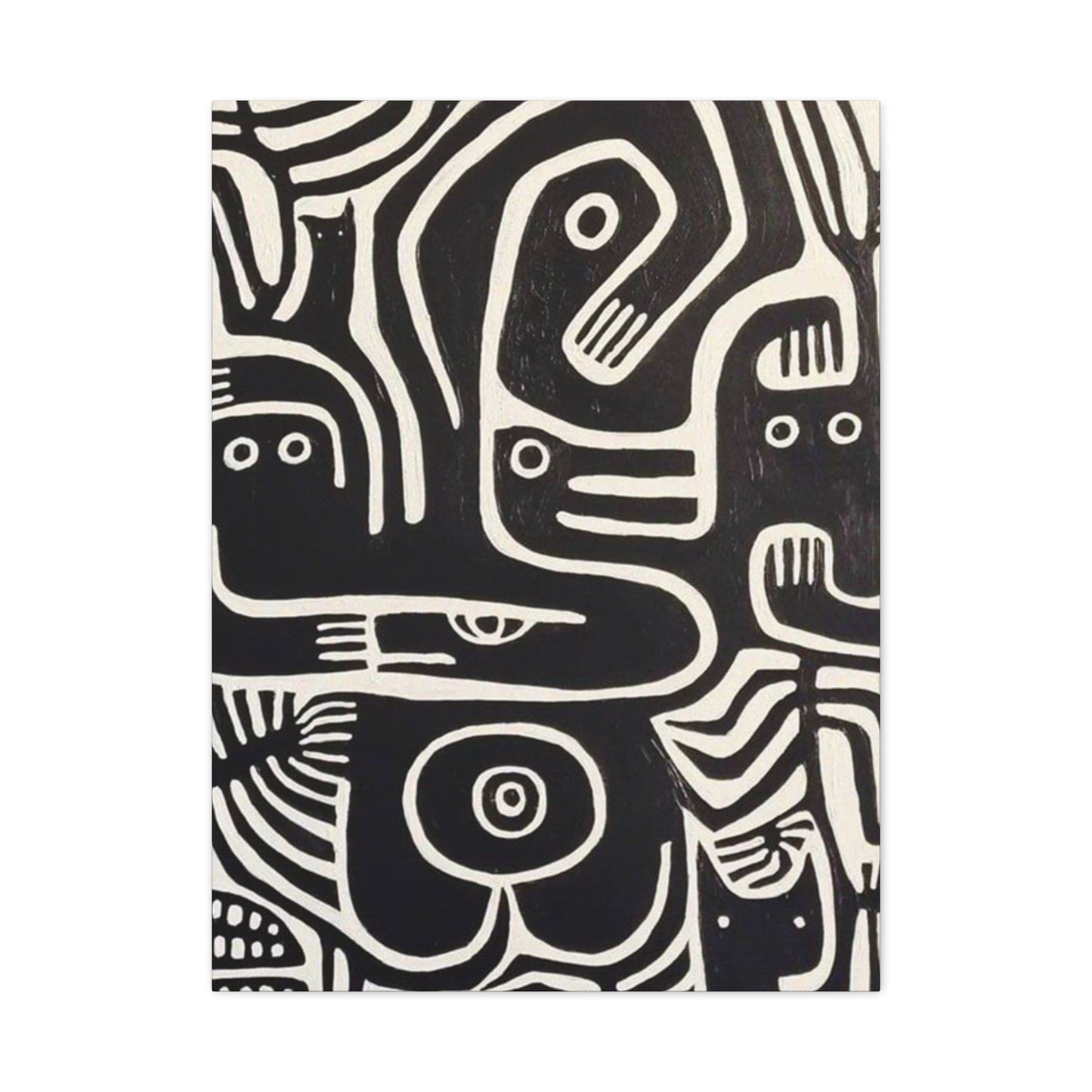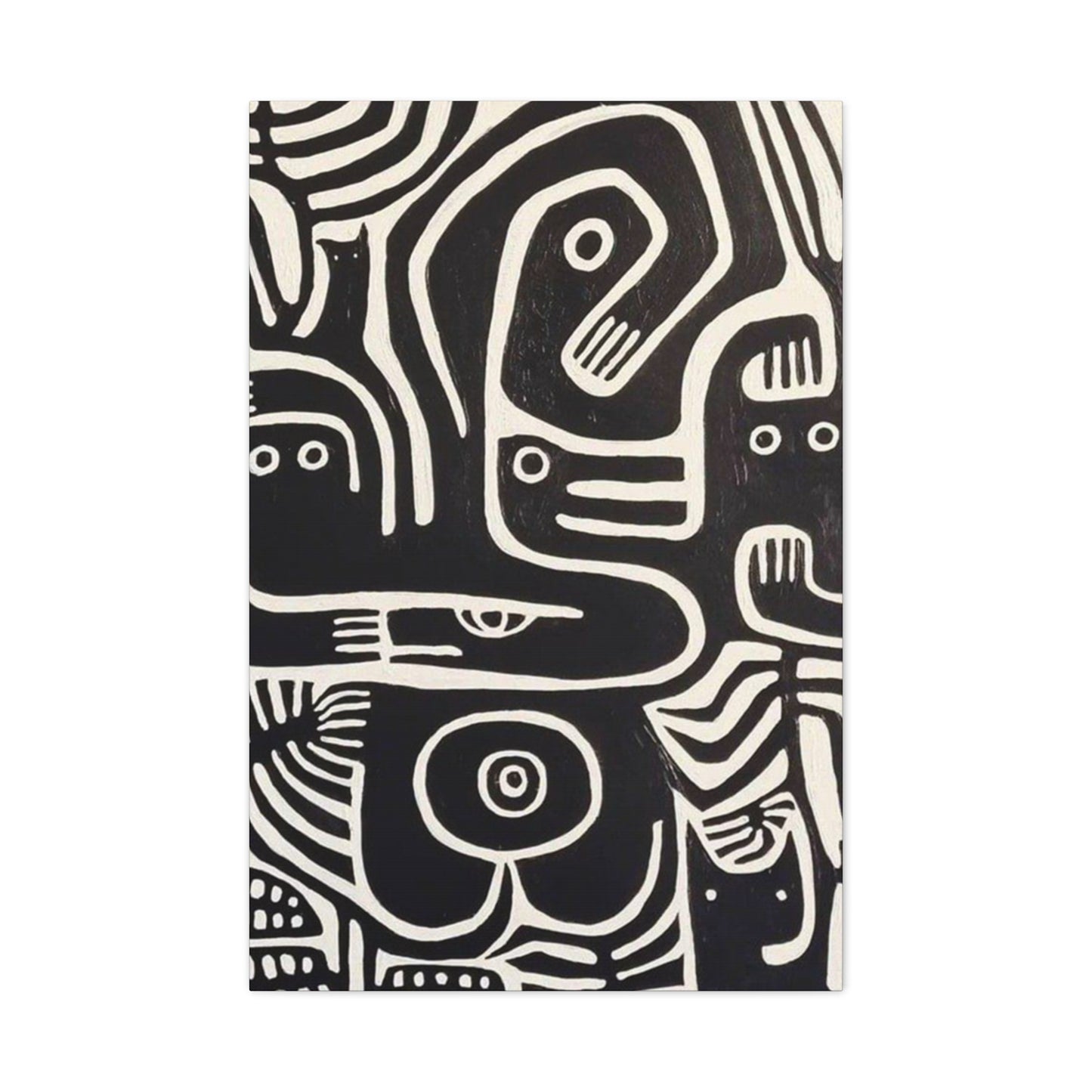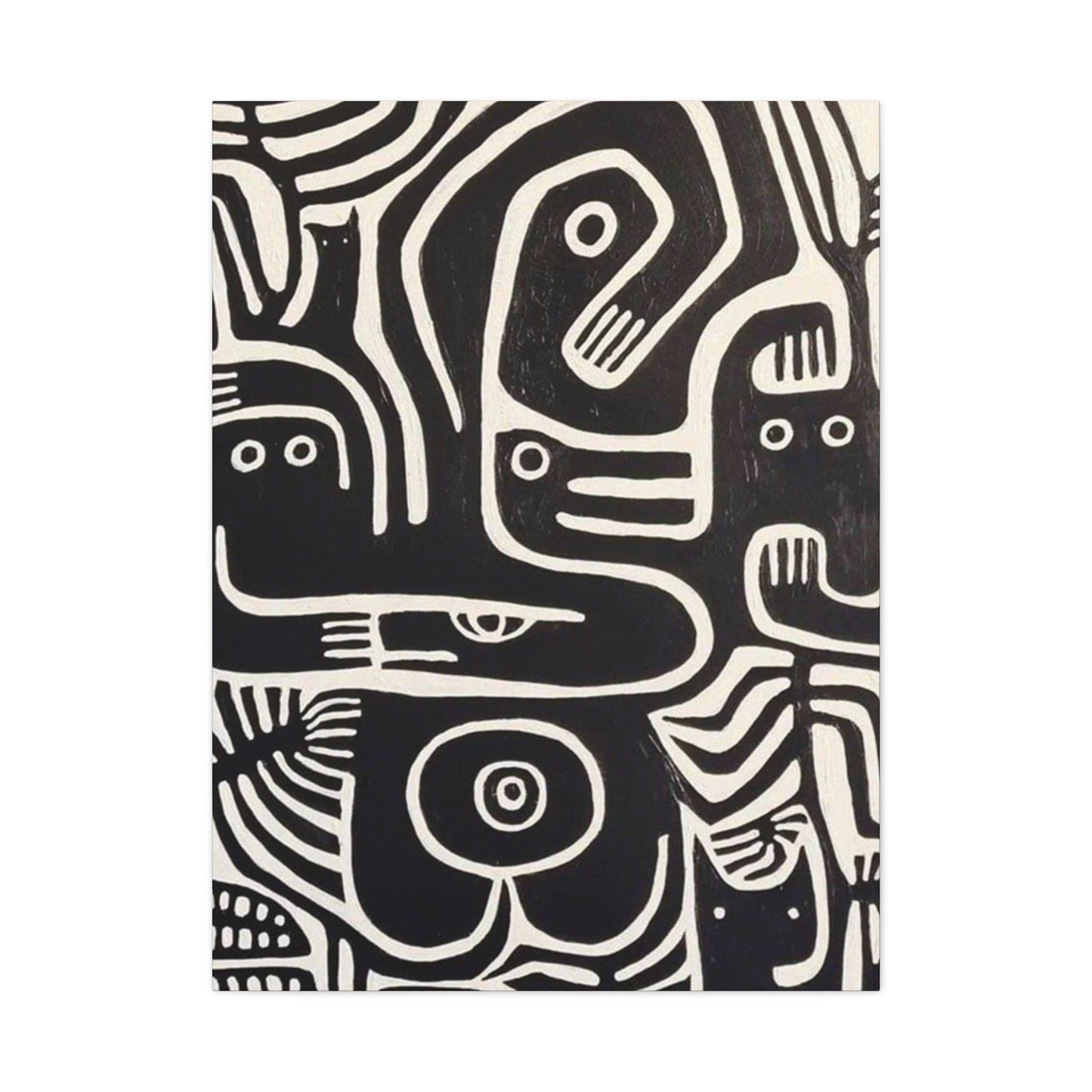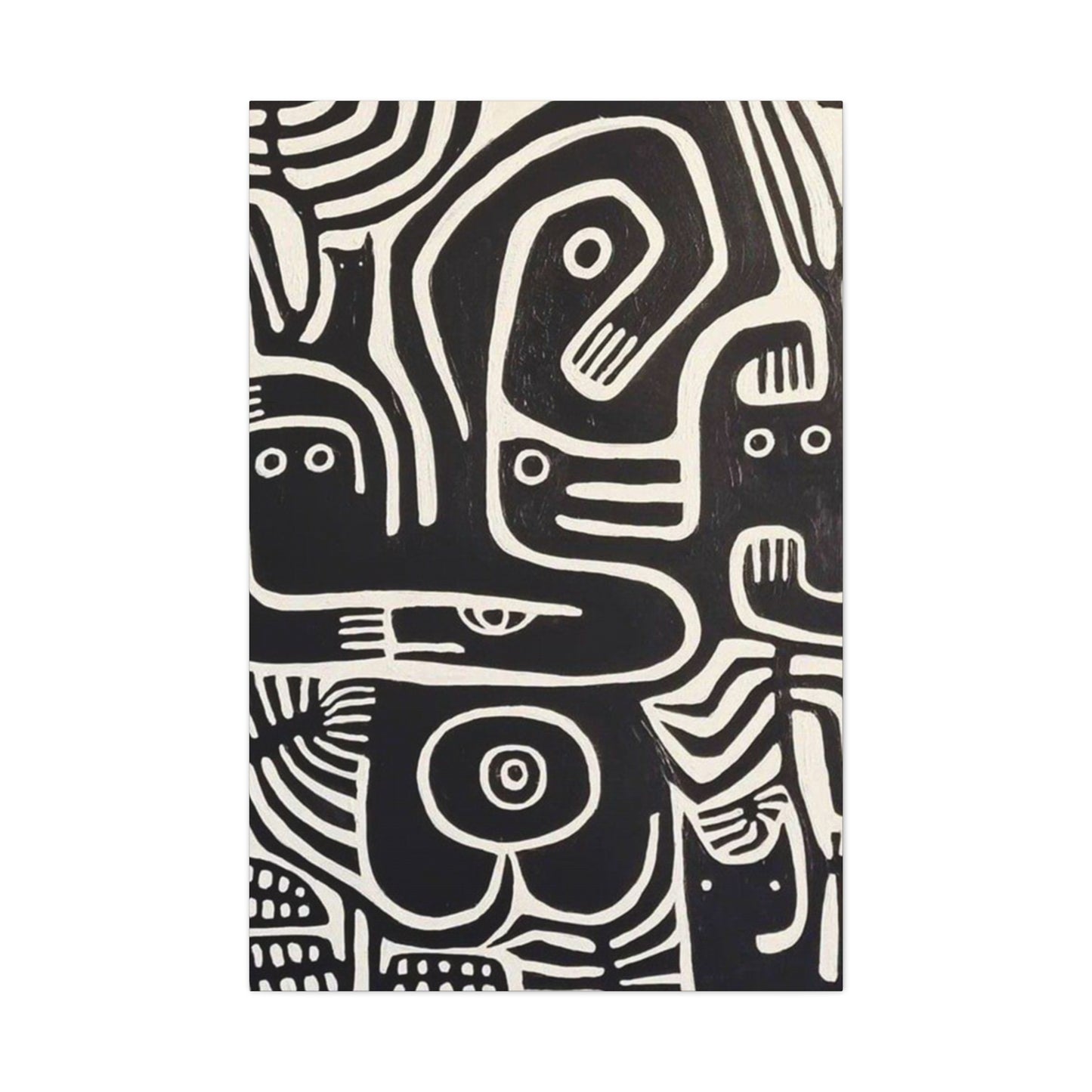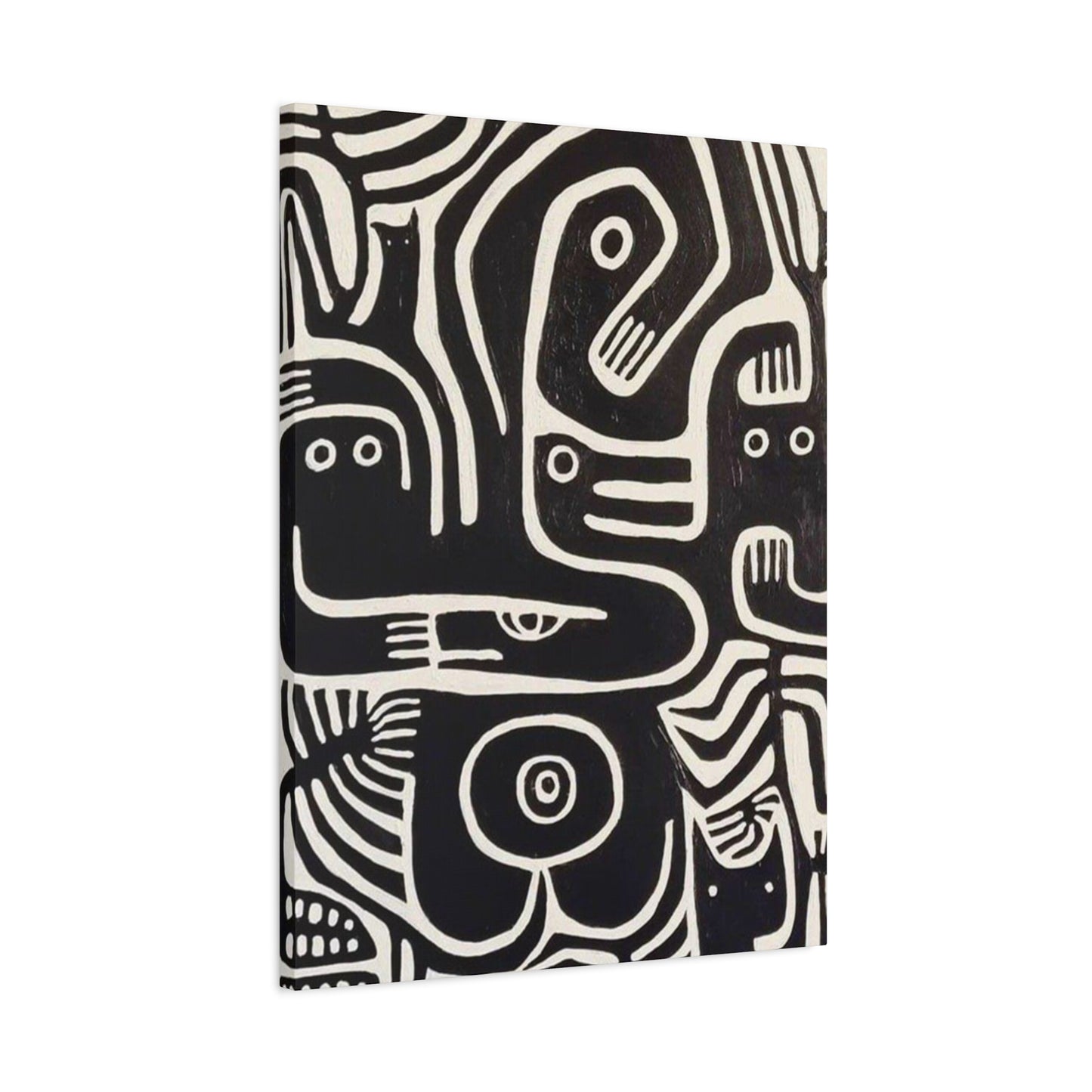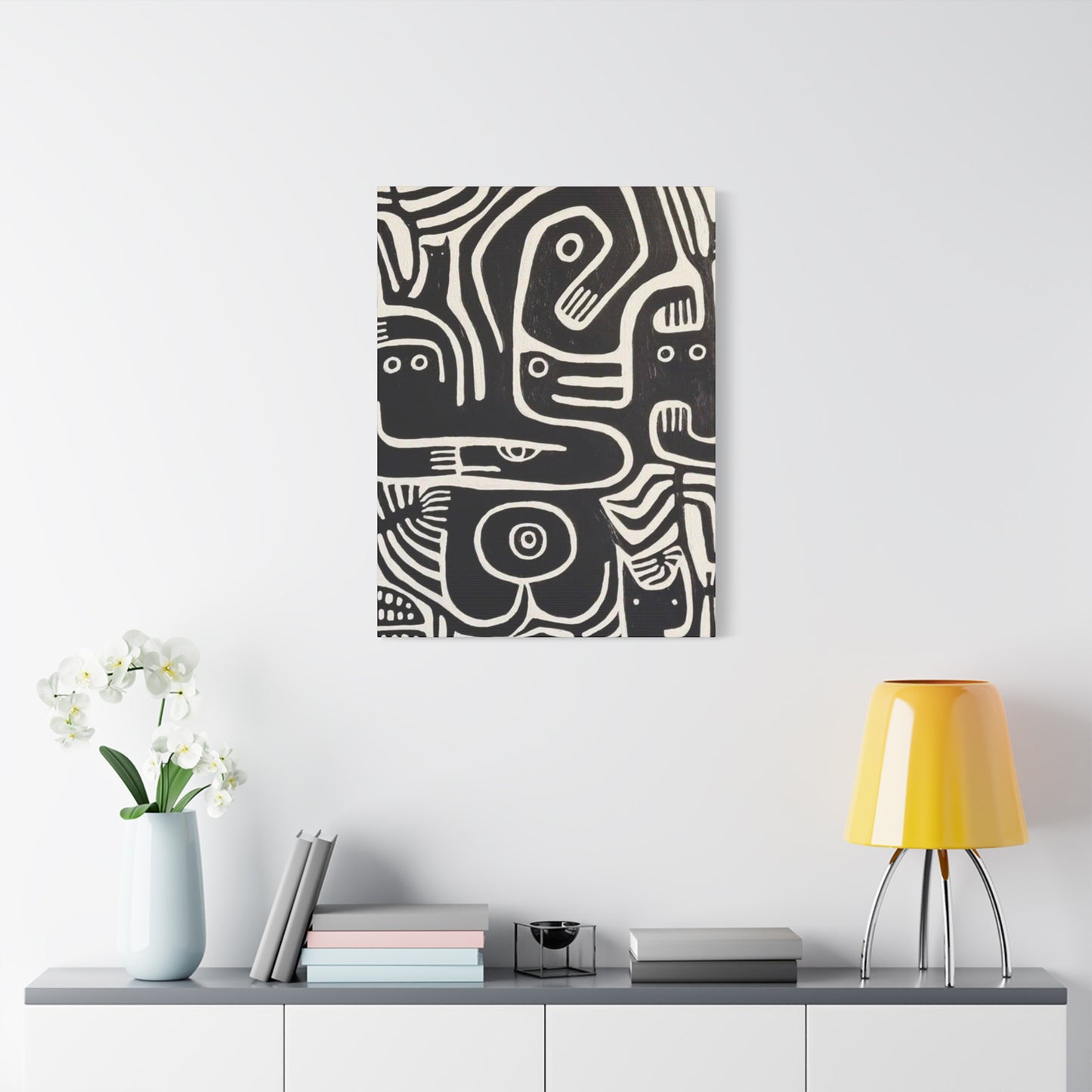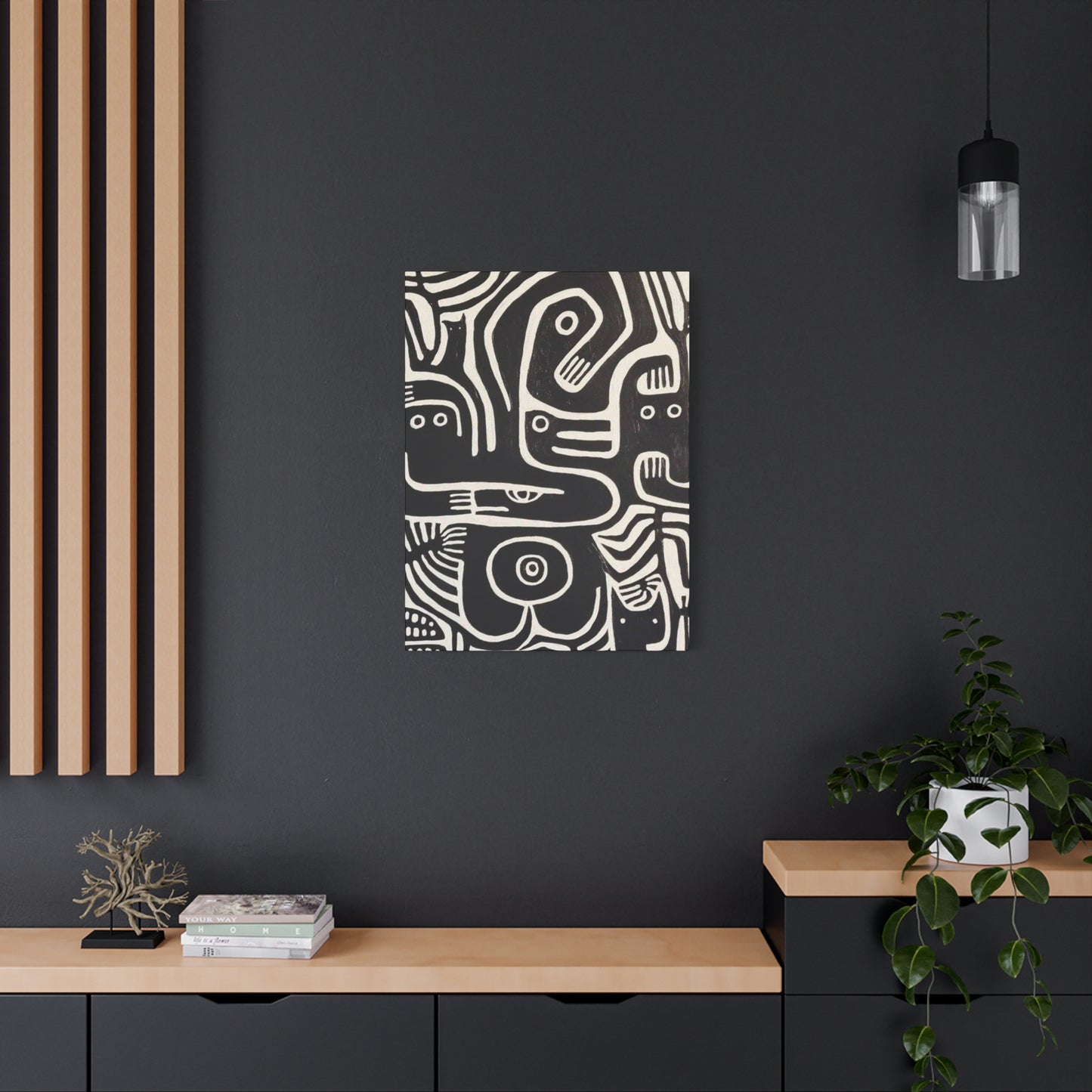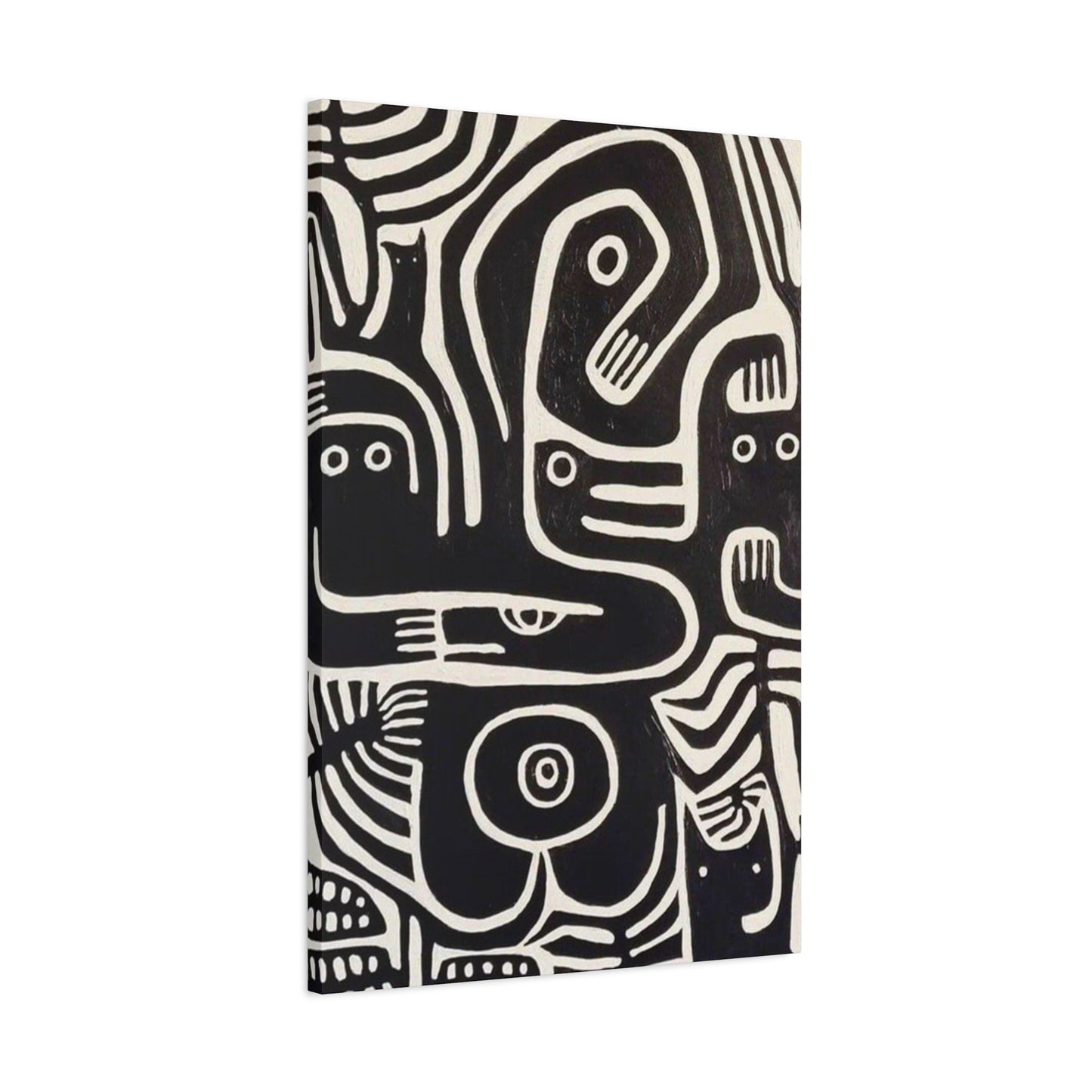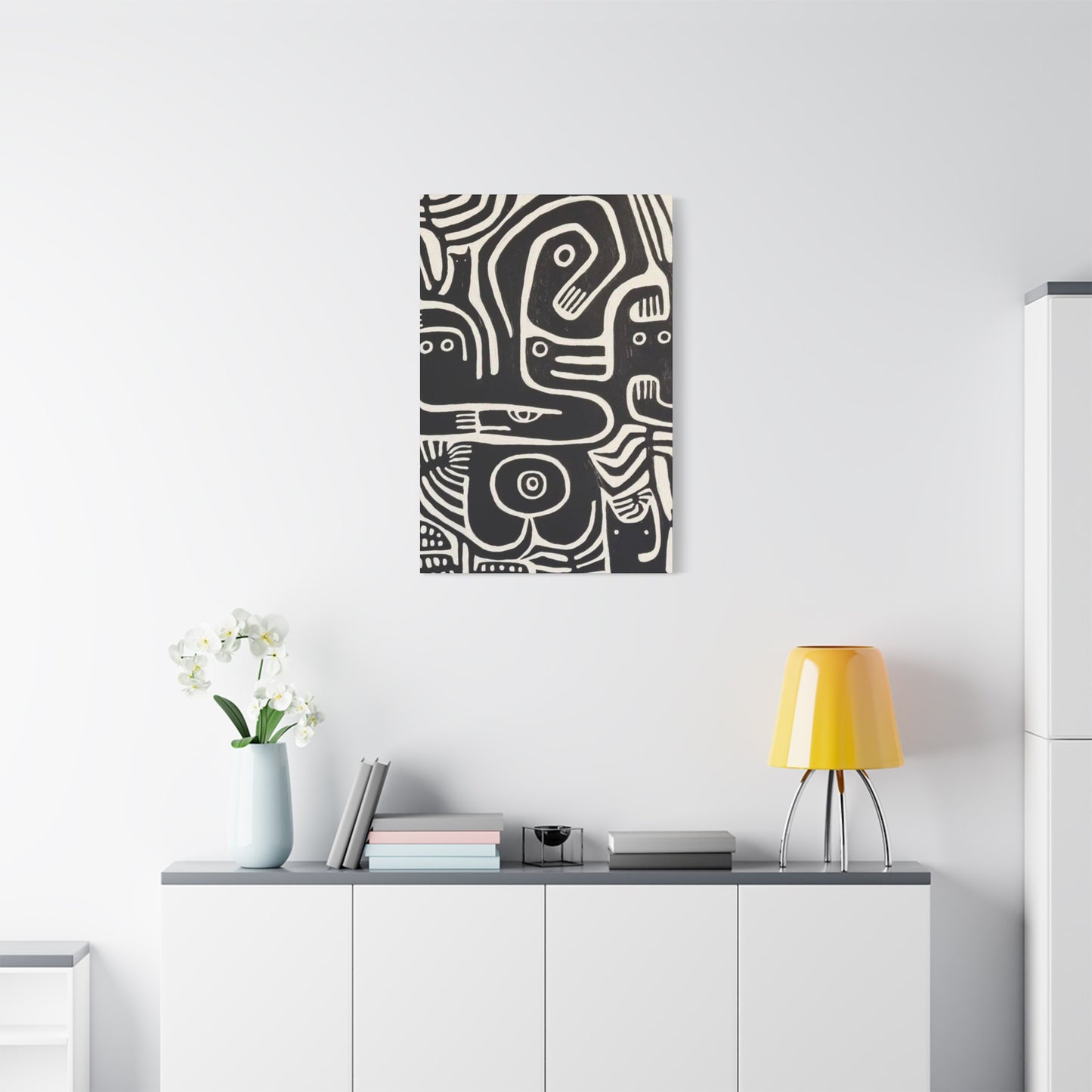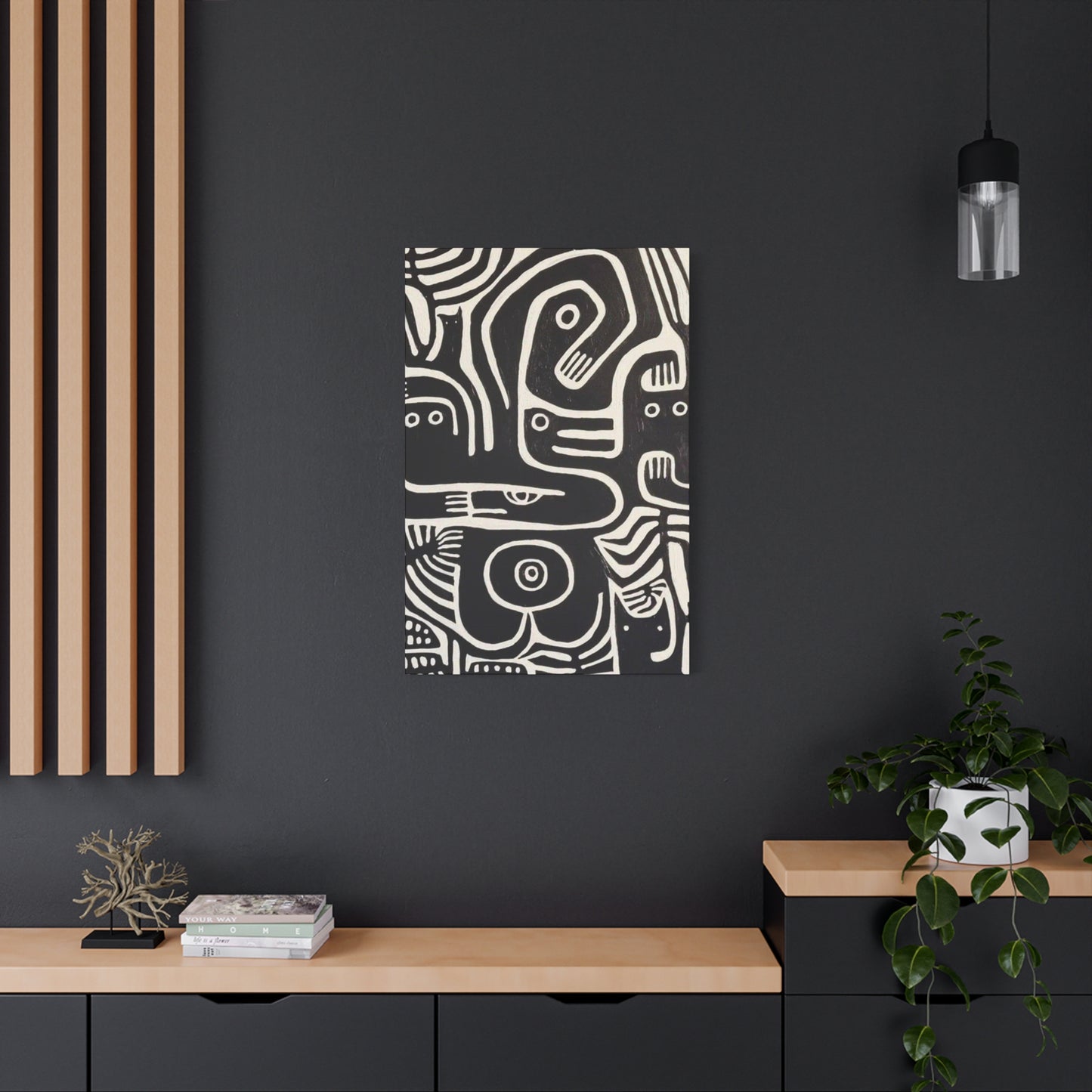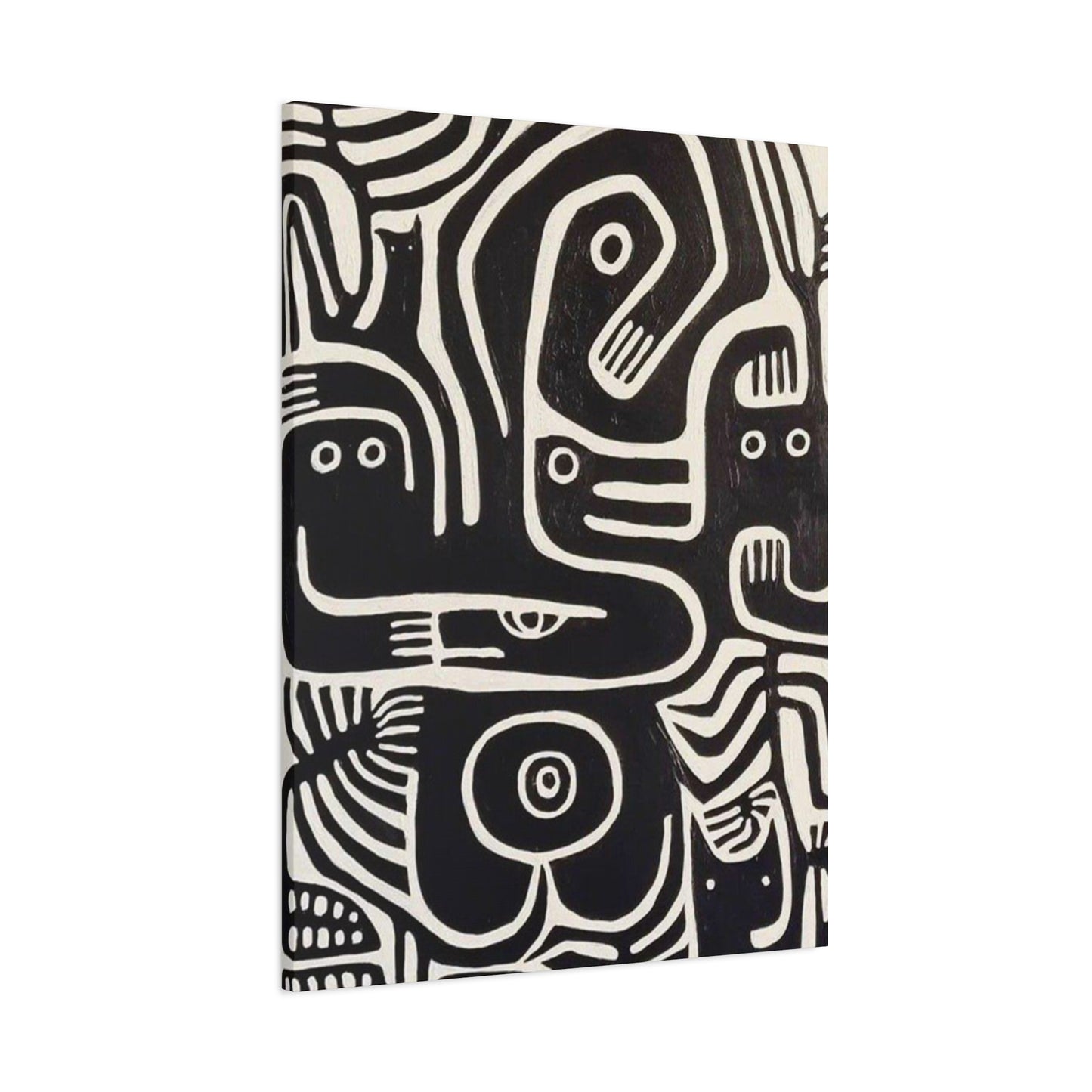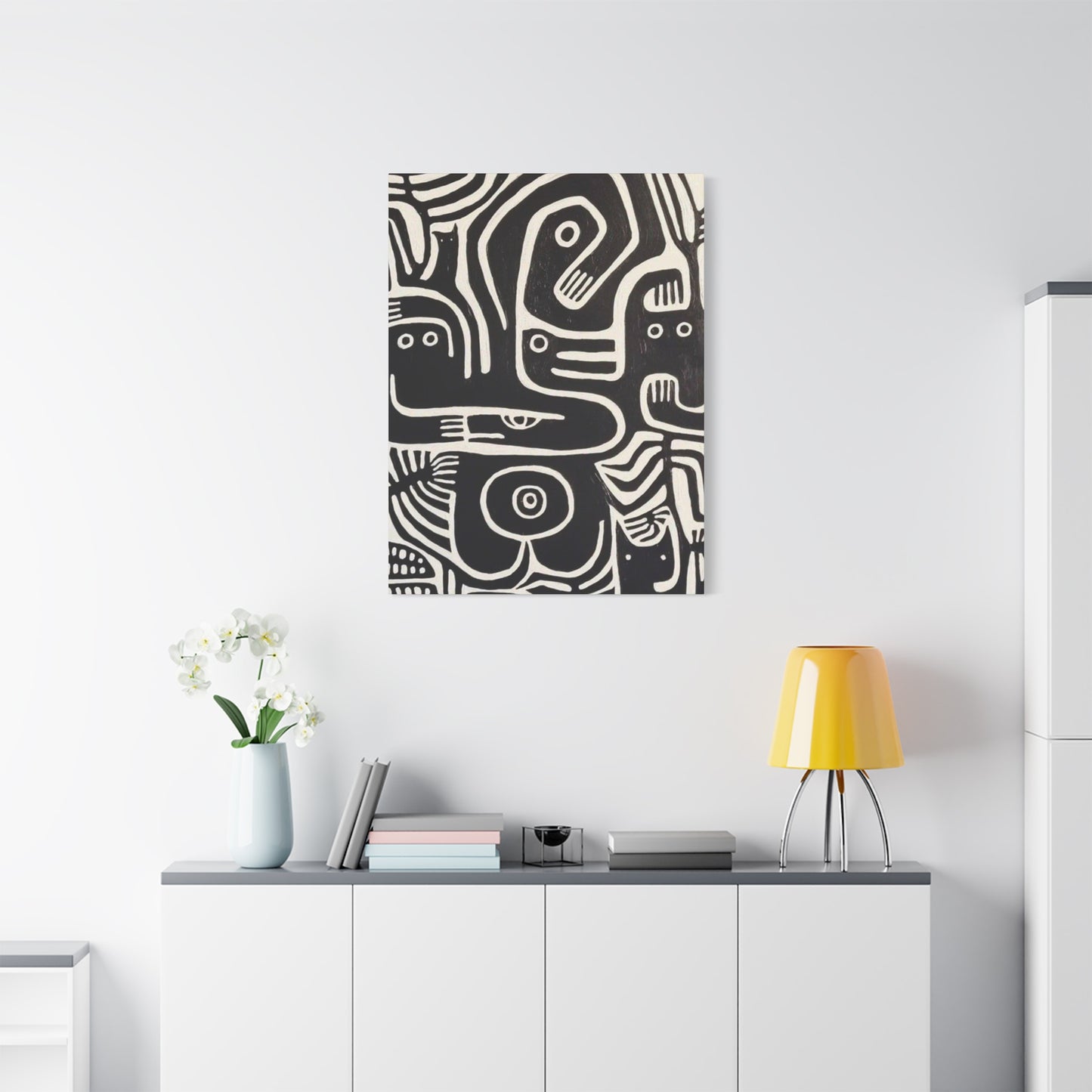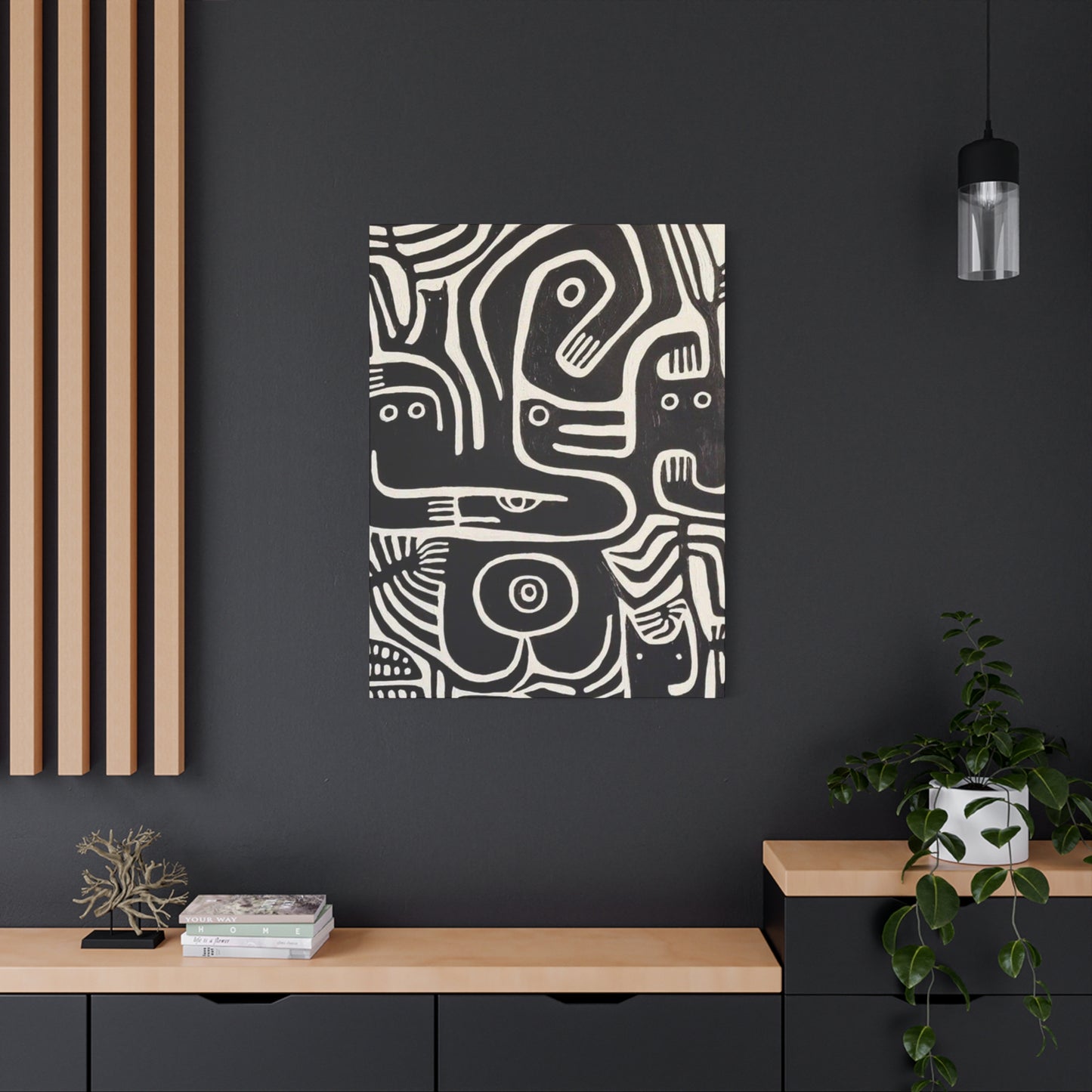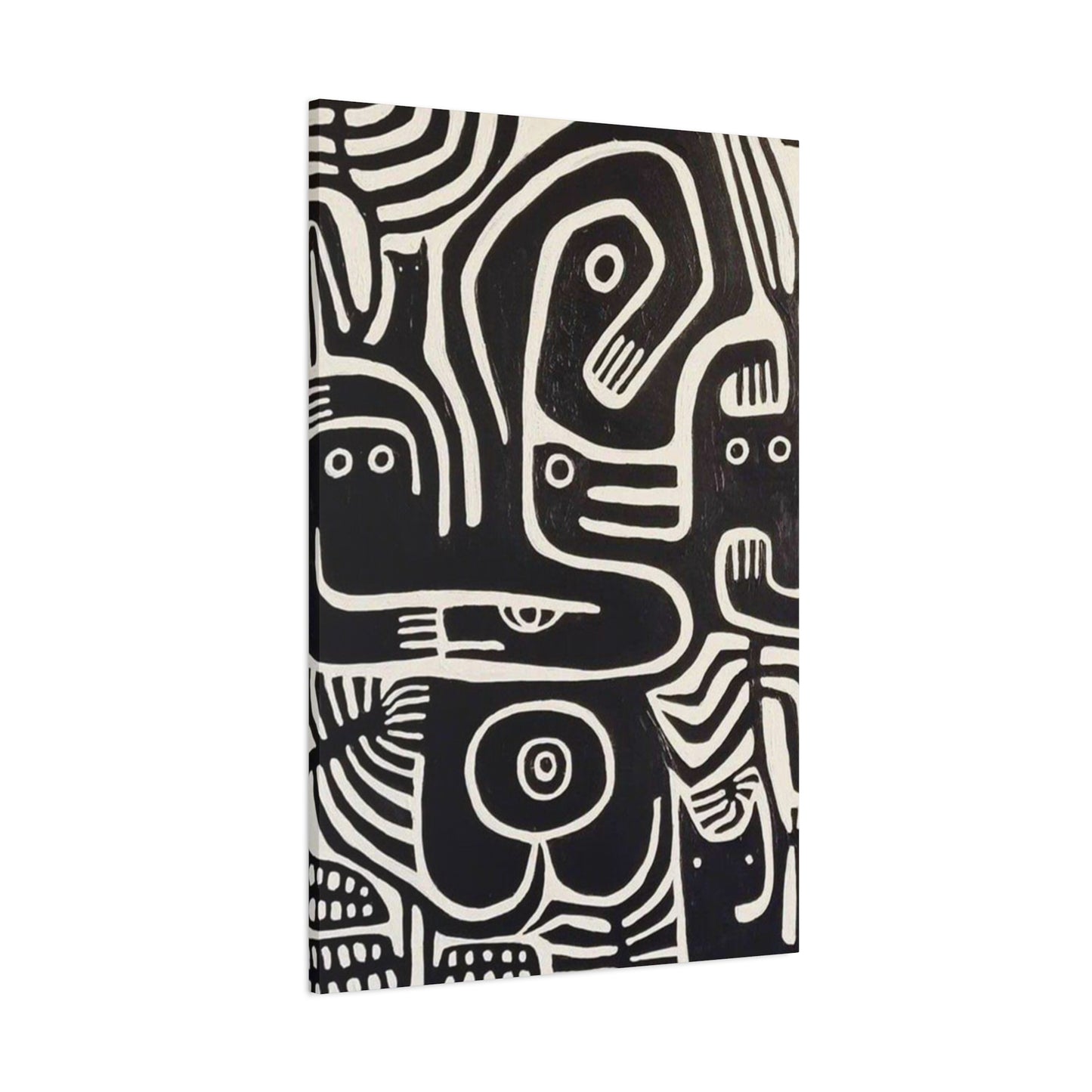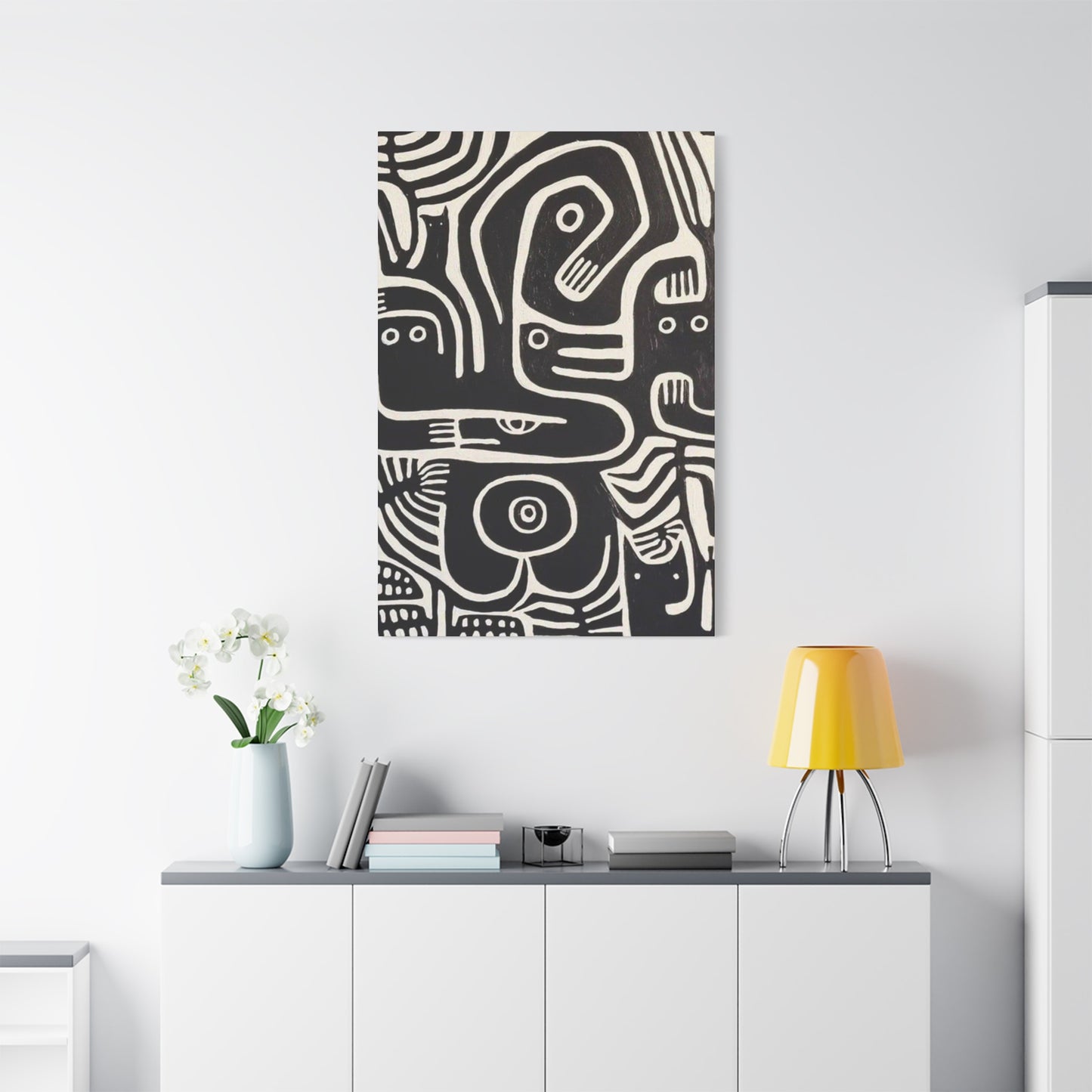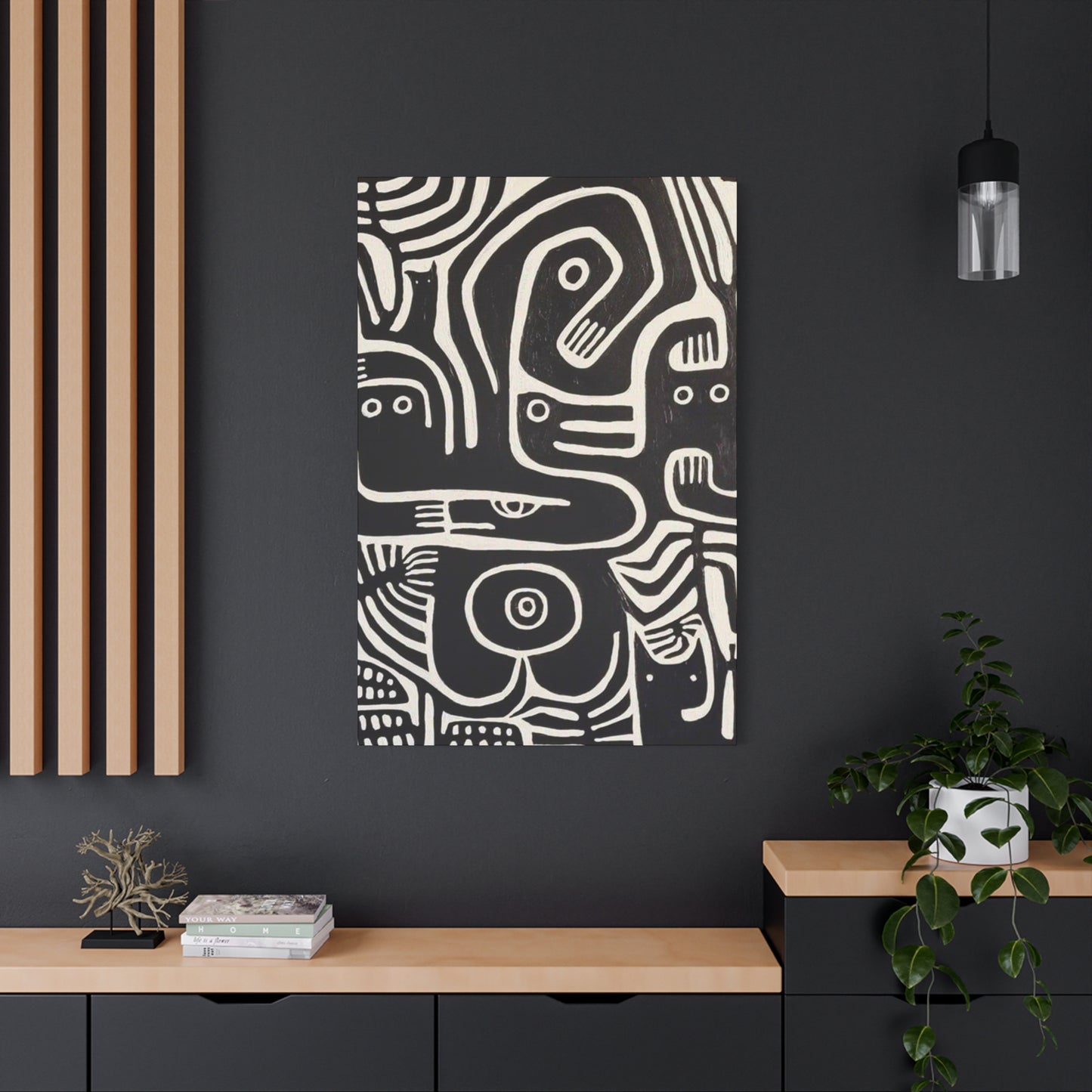The Captivating Allure: Exploring Black Cat Wall Art in Monochromatic Design
The convergence of two powerful aesthetic forces—the timeless elegance of monochromatic design and the mystical charm of the black cat—creates a striking and sophisticated niche in interior décor: monochrome black cat wall art. This isn't just a simple piece of decoration; it's a statement about style, mood, and personality. The absence of color simplifies the visual plane, drawing all attention to the dramatic silhouette, the subtle texture, and the expressive gaze of the feline subject. It transforms a common household image into a piece of gallery-worthy graphic design. In a world saturated with vibrant, high-definition color, choosing a monochrome approach is a deliberate, powerful act of refinement, proving that less truly can be more.
Monochrome black cat wall art speaks to the harmony of simplicity and emotion. The use of black, white, and shades of gray allows for a heightened focus on contrast and composition. Every detail—the curve of the cat’s tail, the glint of its eyes, the texture of its fur—is magnified through light and shadow. This dynamic interplay creates a sense of mystery and sophistication that draws the viewer in. For many, black cats symbolize independence, intuition, and quiet strength, and these traits resonate beautifully when expressed in a monochrome palette. The absence of color enhances the symbolism, turning the cat into both a literal and metaphorical subject—an emblem of enigmatic beauty and resilience.
In contemporary interiors, such artwork serves as a versatile design element. Whether featured in a minimalist space dominated by neutral tones or juxtaposed against bold modern décor, monochrome black cat wall art seamlessly adapts while maintaining its visual power. It can be printed on high-quality canvas, framed in sleek black metal, or displayed as a large photographic mural. Each variation creates a different mood—ranging from elegant and understated to bold and dramatic. Its ability to complement diverse design styles, from Scandinavian simplicity to industrial chic, makes it a timeless addition to any art collection.
Moreover, the emotional depth of monochrome art lies in its capacity to communicate without distraction. By stripping away color, the focus shifts entirely to form, tone, and feeling. The gaze of the black cat—sometimes curious, sometimes contemplative—invites personal interpretation. For some, it may evoke comfort and companionship; for others, it may suggest mystery or power. This open-endedness is what gives monochrome black cat wall art its enduring appeal. It’s not just an image—it’s an experience, a dialogue between the artwork and the viewer.
Deconstructing Monochromatic Wall Art
Monochrome, often mistakenly thought to mean only black and white, actually refers to the use of variations in lightness and saturation of a single color, including shades of gray. In the context of black cat art, it specifically leverages the high-contrast drama achieved by pairing deep blacks with bright whites, or a nuanced scale of grays. This technique is more than a stylistic choice; it's a fundamental principle of visual art that forces the viewer's focus onto form, line, and composition.This stark palette eliminates the distraction of color, compelling the artist and the viewer to appreciate the pure geometry and emotion conveyed by the lines. A black cat’s natural stealth and sleek profile are perfectly suited to this treatment.
Their form becomes a sophisticated, graphic shape against a light background, or a mysterious, subtle shadow emerging from a darker canvas. The resulting artwork doesn't just hang on the wall; it engages with the space, influencing the perceived depth and light of the room. By limiting the color spectrum, the artwork gains an immediate, enduring quality that transcends fleeting trends, establishing it as a pillar of sophisticated interior design. The precision required in shading and texture application within a monochrome piece elevates it from a mere illustration to a careful study of light on form, demanding respect for its technical execution.
The Enduring Symbolism of the Black Cat in Art
The black cat has always occupied a complex and layered space in human culture and art history. Far from being just a domestic pet, it is a creature steeped in folklore, mythology, and psychological projection. Historically, the black cat has been a symbol of both bad luck and good fortune, witchery and elegance, mystery and domesticity. This duality is its greatest asset in art.In a monochrome artwork, the cat's inherent mystique is amplified. The shadowy, undefined nature of the black form allows it to embody these contrasting meanings simultaneously.
It can represent independence and quiet contemplation, or it can nod to the deeper, unseen forces of the world. Artists use this rich symbolic history to imbue the work with an emotional resonance that goes beyond the literal depiction of an animal. A simple black silhouette, therefore, is never truly simple. It carries the weight of centuries of human superstition and reverence, making it a profound and thought-provoking choice for wall décor. The sleek lines and intense eyes typical in depictions draw on an archetype that is universally recognized, providing a piece of wall art with immediate, powerful communicative ability, regardless of the room’s décor style.
A Deep Dive into Monochromatic Wall Art Styles
The term “monochrome black cat wall art” encompasses a wide spectrum of artistic styles, each offering a unique visual and emotional experience. While the central subject—the black cat—remains consistent, the artistic approach and technique determine how the piece resonates with its surroundings. From minimalist sketches to hyper-detailed photographic prints, every monochrome interpretation tells a slightly different story, reflecting the mood, personality, and aesthetic goals of the space it inhabits.
One of the most popular approaches within this category is photographic realism. In this style, the artwork captures the cat’s natural features in exquisite detail, highlighting textures such as fur, whiskers, and eyes with striking precision. The interplay of light and shadow gives the subject an almost tangible presence, as if the cat could leap from the wall at any moment. This form of realism works beautifully in modern or industrial interiors, where clean lines and metallic accents amplify the sharp contrasts of monochrome tones.
In contrast, abstract monochrome compositions take a more interpretive route. Rather than focusing on the cat’s literal form, these works explore its spirit through bold brushstrokes, geometric patterns, or fluid ink designs. Here, the feline becomes a symbol—representing mystery, independence, and grace through shape and motion rather than detail. Abstract pieces are ideal for contemporary or minimalist spaces, where their fluidity adds sophistication without overwhelming the room.
Silhouette art stands at the crossroads between simplicity and drama. By isolating the cat’s outline against a plain white or textured background, the artist creates an immediate focal point. These pieces rely heavily on composition and negative space, allowing viewers to project their interpretations onto the form. Silhouette designs are especially effective in Scandinavian and minimalist settings, where balance, order, and calm define the visual experience.
Another captivating approach is digital vector art, which introduces a modern edge to the monochromatic theme. Using clean, sharp lines and bold contrasts, these artworks merge graphic design principles with fine art sensibilities. They’re particularly popular in urban apartments, offices, and creative studios—spaces that celebrate innovation and clarity. The smooth gradients and stylized precision of digital techniques lend the black cat a futuristic aura while maintaining its timeless mystery.
Finally, mixed-media monochrome pieces blend various materials—such as charcoal, ink, and acrylics—to create rich textures and depth. This approach celebrates imperfection, inviting tactile curiosity and emotional warmth. Whether smudged, splattered, or layered, these works embody a handcrafted authenticity that complements rustic, bohemian, or eclectic interiors.
Minimalist Line Art and Silhouette
Minimalist line art and silhouette designs embrace the philosophy of “less is more.” In this style, the artist distills the essence of the subject—the cat—into its most fundamental forms: outlines, curves, and negative space. A single, unbroken line may capture the entire figure, from the arch of the cat’s back to the flick of its tail. Alternatively, a bold black silhouette might portray the animal in repose or mid-motion. This stark simplicity gives the piece a quiet strength. It is both expressive and restrained, allowing the viewer’s imagination to fill in the unseen details.
This approach aligns perfectly with modern minimalist aesthetics found in Scandinavian and contemporary interiors. Its clean design complements uncluttered spaces, neutral color palettes, and streamlined furniture. The power of this art form lies in its clarity and visual balance—it doesn’t demand attention but effortlessly becomes a statement of sophistication. Minimalist cat line art works beautifully in living rooms, offices, or bedrooms that value serenity and visual harmony.
Moreover, the linear form has a poetic quality. The curve of a tail or the sharp angle of pointed ears becomes symbolic rather than literal. These small gestures transform the cat into a timeless design motif rather than a simple depiction of an animal. This makes minimalist line art adaptable—it can appear playful or elegant depending on the context. In essence, minimalist and silhouette-based black cat art achieves depth and beauty not through complexity, but through purity of form and thoughtful restraint.
Photographic and Grayscale Realism
Photographic and grayscale realism represents the other end of the monochromatic art spectrum. Where minimalism relies on suggestion, realism immerses the viewer in detail. Artists working in this style use the full grayscale range—from the deepest black to the lightest silver-gray—to portray the cat’s soft fur, reflective eyes, and the delicate contrast between light and shadow. The mastery of tonal value is crucial; it brings volume, texture, and presence to the artwork.This style gives the impression of life frozen in a moment. Every whisker, glint, and soft shadow contributes to a sense of authenticity that feels tangible and emotional. It’s reminiscent of classic black and white photography, invoking nostalgia and elegance while avoiding the distraction of color.
The monochrome palette focuses attention on form, emotion, and atmosphere, transforming a simple cat portrait into a timeless visual narrative.Photographic realism fits seamlessly into sophisticated or traditional interiors. Its refined execution pairs well with dark wood furniture, neutral décor, and settings that favor warmth and texture. Such art can serve as a focal point in living rooms or studies, where it adds quiet drama and introspection.Beyond aesthetics, grayscale realism captures the soul of its subject—the intelligence and mystery that cats naturally embody. It celebrates not only their external beauty but also their inner essence. Through the artist’s skillful manipulation of light and tone, the black cat becomes both real and ethereal, bridging the gap between photographic precision and artistic emotion.
Abstract and Graphic Interpretations
Abstract and graphic interpretations of black cat art push boundaries, turning familiar forms into bold statements of design and emotion. In these works, the cat is not merely drawn—it is reimagined. Artists may deconstruct the feline shape into angular fragments, overlay halftone textures reminiscent of pop art, or create layered compositions filled with movement and rhythm. The result is visual energy rather than realism.
This approach appeals to lovers of contemporary, urban, or industrial aesthetics. Its strong lines, geometric contrasts, and experimental use of space make it a perfect fit for modern lofts, creative studios, and eclectic interiors. The abstract rendering of a cat might appear as a dance of shapes and shadows, inviting interpretation. It captures the energy, grace, and independence cats represent without adhering to their literal form.Black and white abstraction emphasizes the interplay between positive and negative space. A dark silhouette can emerge from swirling lines, while fragmented highlights might hint at fur or motion. The viewer’s eye is engaged in assembling the image, making the experience interactive and intellectually stimulating.
This form of cat art often carries symbolic undertones—representing mystery, freedom, or duality. It evokes curiosity and emotion rather than direct recognition. Abstract monochrome pieces blend art and design, becoming both decoration and conversation pieces. Whether hanging above a couch, desk, or hallway, such artwork injects boldness and individuality into any environment.Ultimately, abstract cat art celebrates artistic freedom. It transforms a universally familiar figure into a vessel for creativity, mood, and conceptual exploration. Through geometry and pattern, it speaks the visual language of modern expression.
Integrating Monochrome Black Cat Wall Art into Interior Design
Choosing and placing wall art is one of the most impactful ways to define the character and atmosphere of a room. Monochrome black cat wall art, with its elegant simplicity and symbolic charm, stands out as a particularly versatile design choice. Its restrained palette allows it to harmonize with almost any interior while adding a layer of sophistication and intrigue. Whether the goal is to create a dramatic focal point or a subtle grounding element, the right monochrome piece can transform a space from ordinary to refined with minimal effort.
Pairing with Color Palettes
One of the greatest strengths of monochrome black cat wall art is its adaptability to virtually any color palette. Because it relies solely on shades of black, white, and gray, it acts as a visual equalizer that balances out other colors in the space. In rooms designed with soft, neutral tones such as beige, cream, taupe, or pale gray, monochrome artwork provides definition and depth. Without this contrasting element, neutral spaces can sometimes feel overly light or indistinct. A black cat silhouette or grayscale print creates a focal point that anchors the design, giving the room a sense of purpose and sophistication. The dark figure of the cat naturally draws the eye, while the surrounding white or negative space prevents the composition from feeling heavy.
In contrast, monochrome art can be equally effective in more vibrant environments. When displayed against bold, saturated hues like emerald green, navy blue, terracotta, or mustard yellow, the artwork serves as a “visual pause.” It provides balance and breathing space amid stronger colors, preventing the décor from becoming overwhelming. The interplay between the dark tones of the cat and the vivid background enhances both elements—the wall color appears richer, and the art stands out with clarity.
For interiors characterized by dramatic, high-contrast schemes—such as black-and-white modernism, metallic finishes, or glass and chrome accents—monochrome cat art becomes an extension of the design language. It reinforces the crisp geometry and graphic intensity often found in minimalist and contemporary spaces. The simplicity of black and white also complements natural materials such as stone, leather, or linen, making it versatile across modern rustic, Scandinavian, or industrial interiors.
Ultimately, the adaptability of black and white art lies in its neutrality and emotional subtlety. It doesn’t compete with color; it enhances it. Whether used to calm a busy palette or to amplify a minimalist one, monochrome black cat art serves as both a grounding visual element and a symbol of quiet elegance.
Scale and Placement Considerations
The size and positioning of monochrome black cat wall art play crucial roles in determining its impact within a space. Large-scale pieces, especially those rendered in minimalist or photographic styles, can serve as commanding focal points. When placed above a sofa, bed, or fireplace mantel, an oversized print establishes balance and proportion, guiding the viewer’s attention and setting the visual tone for the entire room. Its presence can transform an otherwise plain wall into an expressive statement.
Alternatively, a collection of smaller prints arranged in a gallery-style layout offers a different kind of sophistication. Mixing various monochrome cat artworks—silhouettes, abstracts, and photographic pieces—creates rhythm and visual storytelling. A cohesive gallery wall allows the viewer to explore multiple interpretations of the same theme while maintaining stylistic unity. To prevent visual clutter, maintain consistent spacing and alignment between frames, and ensure that the collective arrangement feels intentional rather than random.
Height and positioning are equally vital. The golden rule of hanging art is to place the center of the artwork at eye level—typically between 57 and 60 inches from the floor. This ensures the piece engages naturally with the viewer and integrates seamlessly with furniture lines. In rooms with high ceilings, slightly raising the placement can create a sense of grandeur, while in smaller rooms, keeping the art closer to furniture elements fosters intimacy and coherence.
Lighting further enhances the overall effect. Directional spotlights or picture lights emphasize tonal gradations and textures that are characteristic of monochrome artwork. Soft, warm lighting enhances contrast without glare, while adjustable LED fixtures allow for precision control. If possible, avoid hanging valuable prints in direct sunlight to prevent fading over time.
Framing and Presentation
Framing is often underestimated, yet it is one of the most defining aspects of how monochrome black cat art is perceived. The frame does more than protect—it complements the artwork and integrates it into the broader décor scheme. In minimalist or Scandinavian interiors, where clean lines and uncluttered spaces dominate, a frameless canvas or a slim black metal frame enhances simplicity and modernity. The absence of ornamentation allows the viewer to focus entirely on the artwork’s graphic form and contrast.
For more traditional or transitional spaces, framing choices lean toward richer materials and layered presentation. A wide white or off-white mat creates breathing space between the artwork and the frame, giving the piece room to “breathe” visually. A dark wood or black lacquer frame then provides definition and weight, making the art appear grounded and timeless. The matting technique also helps emphasize negative space, a vital aspect of monochrome compositions.
Cohesion is key. The frame’s material and finish should resonate with other design elements in the room—such as the metallic trim of lamps, the legs of a table, or the tone of nearby furniture. This subtle repetition ties the art seamlessly into the environment. For example, a brushed steel frame may echo a chrome floor lamp, while a walnut frame might coordinate with wooden flooring or cabinetry.
Glass choice is another critical factor. Standard glass provides clear visibility but can create glare under strong lighting. Museum-quality non-glare glass or acrylic offers a refined, matte finish that enhances depth without reflection. It also protects delicate prints from dust and UV light.Proper presentation extends beyond framing to wall context. Monochrome cat art stands out beautifully on matte walls, especially in neutral tones. For gallery-style displays, even spacing and consistent framing styles contribute to a professional, curated appearance.
The Psychological Impact of Monochromatic Imagery
Monochrome art engages the human brain in a way that differs fundamentally from its response to full-color imagery. When color is removed from the visual field, our perception shifts toward the subtleties of light, shadow, texture, and form. This reduction of sensory input heightens awareness of composition and emotional nuance, creating a deeper and more contemplative interaction between viewer and artwork. In the context of interior design, monochrome art—particularly black and white imagery—serves as a psychological counterbalance to the overstimulation of modern life. It channels focus and serenity, reshaping the atmosphere of any space it occupies.
The absence of color does not equate to a lack of emotion; rather, it amplifies emotion through subtlety. Black evokes strength, sophistication, and mystery, while white represents clarity, purity, and calm. The interplay between these tones mirrors the human experience—complex yet composed, dynamic yet balanced. Psychologically, the human eye perceives black and white as stable and structured. This visual stability can create feelings of security and harmony within a room. In essence, monochrome art strips away distractions and invites viewers to slow down, breathe, and engage more intentionally with their surroundings.
In minimalist and contemporary interiors, monochrome imagery acts as a grounding force. It softens the sensory overload that often accompanies busy patterns or vivid colors, making it an ideal choice for individuals seeking calm in their environment. The limited palette encourages visual stillness, fostering spaces that feel both meditative and intelligent. Studies in visual psychology suggest that when the brain processes fewer chromatic elements, cognitive clarity increases. This explains why many people find black and white art conducive to focus, thought, and emotional equilibrium.
Monochrome wall art also stimulates deeper emotional resonance. Without the immediate influence of color associations—like the warmth of red or the coolness of blue—the viewer interprets the scene more personally. Each line, shadow, and form becomes an open-ended symbol, allowing individual feelings to emerge freely. This psychological openness makes monochromatic imagery particularly effective for introspective environments such as reading nooks, art studios, or bedrooms, where quiet contemplation is desired.
Furthermore, monochrome art communicates timelessness. Its visual simplicity transcends trends and eras, evoking a sense of permanence and reliability that many find comforting. Whether depicting a black cat’s gaze or an abstract landscape in grayscale, the emotional effect remains the same: understated sophistication and emotional depth. In a fast-paced, color-saturated world, monochrome imagery offers a rare kind of visual refuge—a return to simplicity that nourishes both the eye and the mind.
Creating Calm and Focus
=The reduced sensory load of black and white art is inherently calming and sophisticated, providing a visual rhythm that invites serenity and mindfulness. In an age where digital screens and vivid advertising dominate daily life, monochrome artwork acts as an antidote to overstimulation. Its clean contrasts and refined aesthetic create a space where the mind can rest without disengaging. Instead of demanding attention, monochrome art quietly commands it, drawing the viewer inward through stillness and structure.
In spaces dedicated to relaxation or productivity—such as bedrooms, meditation corners, or home offices—black and white artwork serves as both decoration and design therapy. The simplicity of the color scheme eliminates visual clutter, allowing the eye to move effortlessly across the composition. This uninterrupted flow supports cognitive focus and emotional steadiness. The brain, no longer overwhelmed by competing colors, channels its attention toward essential elements like line, proportion, and light. The result is a soothing environment that encourages clear thinking and creativity.
Moreover, monochrome wall art subtly reinforces spatial harmony. Its neutrality integrates easily with varied color palettes, making it an ideal anchor for interior balance. A black cat silhouette on a white background, for instance, introduces elegance without overwhelming the décor. The restrained palette acts as a bridge between contrasting design elements—warm wood tones, cool metals, or bright textiles—tying the room together with quiet cohesion.
The psychological benefits extend beyond aesthetics. Scientific research in environmental psychology indicates that environments with fewer visual stimuli reduce stress and improve attention spans. Black and white art aligns perfectly with this principle, offering tranquility without sterility. Its presence promotes mental clarity and reflection, making it ideal for those who value mindfulness and minimalism.
In personal or professional settings, monochrome art cultivates an atmosphere of quiet confidence. The absence of distraction allows individuals to immerse themselves fully in thought or rest, making such spaces feel simultaneously productive and restorative. Whether it’s a black cat portrayed in soft grayscale or a sharp geometric design, monochrome wall art achieves what few decorations can: it calms the mind while sharpening focus. This balance of tranquility and precision transforms not just walls, but entire moods—reminding us that simplicity is not emptiness, but an invitation to clarity.
Excellence of Monochrome Printing
The beauty and sophistication of monochrome black cat wall art depend not only on artistic vision but also on the precision and quality of its printing. In monochrome artwork, every shade, highlight, and transition between black, gray, and white must be perfectly balanced. Unlike color printing—where variations in hue can sometimes disguise flaws—black-and-white printing is utterly unforgiving. Even minor inconsistencies in tone, contrast, or ink distribution can flatten the image or cause unwanted color tints. This is why achieving technical excellence in monochrome printing requires specialized equipment, meticulous calibration, and a deep understanding of grayscale reproduction.
Professional monochrome printing elevates the art from mere decoration to a refined visual experience. The challenge lies in preserving the emotional and tonal integrity of the original artwork. The goal is to reproduce the cat’s fur texture, the interplay of light and shadow, and the subtle gradations that give the subject life and dimensionality. A high-quality monochrome print should have deep, velvety blacks, crisp midtones, and delicate highlights that retain their clarity.
Moreover, the choice of medium—paper or canvas—also plays a critical role in the final presentation. Textured fine art paper enhances the organic depth of ink, while smooth cotton rag or matte canvas creates a modern, gallery-quality finish. When paired with proper lighting, a professionally printed monochrome piece commands presence, exuding both sophistication and emotional resonance.True excellence in monochrome printing is thus both a science and an art. It demands precision in ink formulation, printer calibration, and substrate choice. When executed correctly, the result is more than an image—it becomes a timeless visual statement that endures both physically and aesthetically.
Giclée Printing and Archival Quality
Giclée printing has become the benchmark for fine art reproduction, and its advantages are particularly evident in monochrome black cat wall art. Derived from the French word gicler, meaning “to spray,” this process uses advanced inkjet technology to deposit millions of microscopic pigment-based ink droplets onto a high-quality substrate, such as cotton rag paper or fine art canvas. The precision and tonal control achieved by this method are extraordinary, especially for black and white imagery that demands nuance and depth.
Unlike standard printers that rely on composite blacks made from colored inks (cyan, magenta, and yellow), Giclée printers often employ a dedicated grayscale ink set. These include multiple shades of black and gray—sometimes seven or more—allowing for smoother tonal transitions and eliminating unwanted color shifts (a phenomenon known as metamerism). This meticulous process results in a depth of black that is both rich and multidimensional. The shadows within the cat’s fur, the soft glint in its eyes, and the reflective highlights of light on the coat appear lifelike and tangible, rather than flat or overly contrasted.
Another key advantage of Giclée printing lies in its archival quality. The pigment-based inks used in this method are renowned for their durability and resistance to fading. When printed on acid-free, museum-grade substrates, the artwork can retain its integrity for over a century under proper conditions. This makes Giclée-printed monochrome art not only a beautiful decoration but a long-term investment in artistic preservation.
Furthermore, the texture of the chosen medium enhances the viewing experience. Matte papers lend softness and refinement, while textured watercolor papers or canvases add a tactile depth that complements the visual richness of monochrome imagery. When combined with professional mounting and framing, Giclée prints possess an elegance and authenticity that rival traditional darkroom photographs.In essence, Giclée printing bridges the gap between digital precision and fine art tradition. It transforms the intricate simplicity of black cat wall art into a luxurious, enduring piece that captures both the spirit of the subject and the timeless beauty of monochrome expression.
Screen Printing: Boldness and Graphic Impact
Screen printing offers a completely different yet equally captivating approach to producing monochrome black cat wall art. This centuries-old technique emphasizes boldness, texture, and visual strength. Unlike Giclée printing—which aims for tonal nuance—screen printing focuses on striking contrast and tactile presence. The process involves pushing layers of ink through a fine mesh screen stencil, with each tonal variation requiring its own screen. The resulting prints are characterized by rich, solid blacks and sharp edges that command attention.
For minimalist or graphic-style artworks, such as cat silhouettes or geometric abstractions, screen printing delivers unparalleled visual clarity. The blacks produced through this method are dense, opaque, and physically tangible—sitting atop the surface of the paper or canvas rather than being absorbed into it. This gives the artwork a sense of texture and craftsmanship that digital printing cannot replicate. The viewer can often feel the slight raised texture of the ink, adding depth and authenticity to the piece.
Screen printing also allows artists to experiment with materials and finishes. Matte or gloss inks can be used to manipulate light reflection, while textured or metallic inks introduce subtle variations in tone. These details enhance the character of the piece, transforming a simple silhouette into a bold statement. The process’s handcrafted nature means each print may carry minor variations, making every piece unique—a hallmark of true artistry.
This printing method pairs perfectly with modern, industrial, or eclectic interiors where raw materials and bold contrasts are appreciated. A large, screen-printed black cat artwork can instantly energize a minimalist room, while a series of smaller prints can create rhythm and personality across a gallery wall.
While screen printing may lack the tonal subtlety of Giclée, its aesthetic power lies in its immediacy. It embodies a fusion of art and craft, offering strong visual impact with a tactile edge. The combination of deep, uniform blacks and crisp lines mirrors the graphic essence of monochrome design, making screen-printed black cat wall art not only visually dynamic but also emotionally compelling—a perfect blend of traditional craftsmanship and modern artistic expression.
Etchings, Engravings, and Intaglio Processes
Before the advent of modern digital printing, many of the world’s most celebrated monochrome artworks were born through the painstaking craft of intaglio printing—a family of traditional techniques that includes etching, engraving, drypoint, and aquatint. These methods date back centuries and are revered for their unmatched precision, tactile quality, and visual depth. For collectors and art enthusiasts, intaglio prints represent not just an image but a direct physical record of the artist’s hand and technical mastery. When applied to subjects like the black cat, these methods transform a simple motif into a sophisticated, textural composition of light, shadow, and emotion.
At its core, the intaglio process involves incising or etching lines into a metal plate—traditionally copper or zinc—using either sharp tools or acid baths. Ink is then carefully worked into the grooves of the plate, and the surface is wiped clean so that only the incised lines retain pigment. A damp sheet of high-quality paper is placed over the plate and pressed under immense pressure through a printing press. The result is an impression in which the inked lines appear slightly raised, leaving a subtle embossed texture that the eye and fingers can both perceive. This tactile element adds an authenticity that mechanical or digital reproduction can never truly replicate.
Etching, one of the most refined intaglio techniques, involves coating the metal plate with a waxy, acid-resistant ground. The artist then uses a fine needle to draw the design by exposing the metal beneath. When the plate is submerged in acid, the exposed lines are “bitten” into the metal. Etchings of black cats often feature graceful, intricate lines—cross-hatched or stippled to convey fur texture, depth, and shadow. The process allows for remarkable tonal gradation, where the softness of the cat’s fur and the gleam of its eyes emerge through careful manipulation of etched lines. The result is a piece that feels both delicate and deeply expressive, bridging technical rigor with emotional resonance.
Engraving, by contrast, requires the artist to incise directly into the metal plate using a burin or graver—a method demanding immense precision and control. Engravings tend to have cleaner, sharper lines than etchings, producing a crisp, almost architectural quality. When used to depict a black cat, engraving brings out striking contrasts and meticulous detail, emphasizing the animal’s musculature, posture, and poise.
Both techniques are capable of producing exceptionally rich blacks due to the large volume of ink that settles into the incised grooves. This density creates a profound sense of depth and visual weight, giving monochrome imagery a physical presence that feels almost sculptural. Because each impression requires careful, manual preparation, intaglio prints are typically released as limited editions, making them highly collectible works of art.
The Evolution of the Feline Form in Graphic Art History
The earliest artistic depictions of cats in monochrome form trace back to the medieval and Renaissance periods, when the limitations of printing technology necessitated creativity through black and white contrast alone. Before the invention of modern color printing or photography, art was reproduced and distributed through woodcuts, engravings, and etchings—mediums that inherently relied on the stark interplay of ink and paper. These early techniques demanded both technical precision and aesthetic restraint, as artists had to convey texture, depth, and expression through nothing more than carved lines and tonal variation.
During this era, the cat often appeared as a symbolic figure. In medieval iconography, cats embodied mystery, independence, and sometimes even danger, due to their association with nocturnal life and pagan folklore. Artists rendered them in sharp, angular compositions that mirrored the Gothic aesthetic of the time. The “Gothic line” became a defining stylistic feature—rigid yet elegant, capturing the cat’s sinewy grace and predatory alertness. Artists used dense cross-hatching, stippling, and fine parallel lines to simulate the softness of fur, the glint of the eyes, and the tension in a crouched pose.
These early monochrome prints were not simply decorative but served narrative and spiritual functions. Cats were depicted in biblical scenes, allegories, and moral tales—sometimes representing deceit and temptation, other times symbolizing intelligence or divine vigilance. Because every image had to be carved by hand onto wood or metal plates, the craftsmanship involved was immense. Each incision was deliberate, each shadow carefully considered. This manual process gave the resulting works an expressive intensity that modern mechanical reproduction rarely achieves.
From a technical standpoint, these early printmakers established many of the foundational principles still used in graphic art today. They mastered the use of negative space to suggest form, the manipulation of light and shadow to create volume, and the control of line weight to convey emotion. In doing so, they elevated black-and-white art from necessity to artistry.
The feline form, in particular, lent itself beautifully to the monochrome medium. Its fluid anatomy, striking silhouette, and subtle textures provided endless opportunities for exploration. These early depictions of cats, rendered with stark precision and emotional depth, not only shaped how animals were represented in Western art but also paved the way for centuries of innovation in line-based illustration. Their influence continues to echo through modern minimalist and monochrome artworks, including today’s black cat wall art that celebrates the same union of simplicity and expressive power.
Art Nouveau and the Flowing Line
The late 19th and early 20th centuries witnessed the emergence of Art Nouveau, an artistic movement that celebrated elegance, organic forms, and the rhythmic beauty of nature. Rejecting the rigid structures of academic art, Art Nouveau embraced sinuous, flowing lines inspired by plants, animals, and the human figure. Within this aesthetic revolution, the black cat found a perfect muse. Its natural grace, curved silhouette, and air of mystery aligned seamlessly with the movement’s ideals. The feline’s supple posture and instinctive poise echoed the “whiplash” curves that defined Art Nouveau design, making it a recurring symbol of beauty, sensuality, and independence.
Artists of the period often depicted cats not merely as domestic animals, but as embodiments of urban sophistication and the allure of the night. In monochrome renderings, the black cat became an icon of mystique and refinement. The flowing lines of its tail and body mirrored the tendrils of vines, the swirl of smoke, or the ripple of hair—each a common motif within Art Nouveau illustration. The use of black ink on pale backgrounds created a striking visual tension: the cat emerged as both shadow and spirit, an elegant form poised between realism and abstraction.
One of the most celebrated figures associated with this imagery was Théophile Steinlen, whose 1896 poster Le Chat Noir immortalized the black cat as a cultural emblem of bohemian Paris. His use of monochrome and limited color palettes accentuated the dramatic silhouette of the feline, transforming it into a symbol of creative rebellion and modern sophistication. In Steinlen’s hands, the black cat was not only a companion of artists and poets but a metaphor for artistic independence and unconventionality.
Monochrome black cat imagery from the Art Nouveau period continues to inspire modern design, embodying a timeless dialogue between nature and artistry. The simplicity of the line and the deliberate control of form remind contemporary viewers that elegance often lies in restraint. Even today, reproductions of these early posters or modern reinterpretations of their style evoke a nostalgic yet enduring sense of artistic refinement—where beauty flows as naturally as ink from a pen.
The Photographic Influence and the Modern Contrast
The introduction of black and white photography in the late 19th century profoundly changed the artistic landscape, redefining how light, form, and emotion were perceived. Unlike drawn or etched lines, photography relied on the interplay between light and shadow to reveal reality with unparalleled fidelity. In the world of monochrome art, this new medium added a layer of immediacy and emotional truth that no previous technique could fully replicate. For representations of the black cat, this meant moving beyond stylization toward lifelike texture, mood, and presence.
Photographers such as Henri Cartier-Bresson—renowned for capturing the “decisive moment”—demonstrated how high-contrast imagery could convey emotion, geometry, and atmosphere with breathtaking precision. Although Cartier-Bresson rarely focused exclusively on cats, his mastery of grayscale composition influenced generations of artists who sought to express narrative and emotion without relying on color. In monochrome black cat photography, this approach translated into works that emphasized the soft texture of fur, the sharp intensity of the eyes, and the subtle dance of light and shadow that defines the animal’s mysterious personality.
Modern digital technology has expanded this tradition while preserving its monochromatic essence. Today’s artists and photographers can manipulate tonal depth, contrast, and sharpness with remarkable precision, achieving visual effects that rival the richness of traditional darkroom processes. The resulting contemporary monochrome black cat wall art blends classic composition with modern clarity—honoring the past while embracing present-day technique.
This synthesis of photography and design bridges centuries of artistic innovation. The structural discipline of engraving, the expressive fluidity of Art Nouveau, and the realism of modern photography converge in one aesthetic vision. The black cat, once a muse for printmakers and poster artists, now finds renewed life in high-definition photographic prints. These works adorn modern interiors with a dual message: they celebrate the timeless beauty of monochrome while showcasing the technical perfection of the digital age.
In essence, the evolution from Art Nouveau illustration to photographic realism marks a fascinating journey of artistic transformation. Both movements—though separated by time and technology—share the same goal: to capture the black cat’s elusive grace and enduring symbolism. Whether rendered in sweeping ink lines or precise photographic contrast, monochrome black cat art continues to captivate the human eye, proving that true elegance transcends color, era, and medium alike.
Conclusion:
The phenomenon of monochrome black cat wall art is far more than a passing trend in interior décor; it represents a powerful confluence of enduring artistic principles and deep-seated cultural symbolism. By committing to the restricted palette of black, white, and the intermediate shades of gray, the artwork achieves an automatic elevation to a realm of sophistication and timelessness. Color is a distraction, and by removing it, the art is forced to speak only in the fundamental language of form, light, and line, a language that has resonated with human perception since the earliest days of drawing and printmaking.
The black cat, already an enigmatic figure throughout history, finds its ultimate dramatic expression in this aesthetic, with its natural silhouette perfectly suited to the graphic intensity of the monochrome medium.This art serves a vital function in contemporary living spaces. It acts as a visual anchor, grounding rooms dominated by neutral tones and providing a necessary moment of visual calm in spaces overwhelmed by color and complexity. Whether expressed through the bold, flat surfaces of a screen print, the hyper-realistic detail of a Giclée photograph, or the fluid strokes of ink and brush, the aesthetic remains potent and versatile, capable of adapting to nearly every architectural and design style.
From the minimalist loft to the traditional study, the image of the black cat, stripped of all chromatic noise, commands attention and conveys an immediate sense of mystery, elegance, and independence. The meticulous technical considerations, from the choice of archival paper and specialized inks to the perfect lighting and framing, all contribute to ensuring that this seemingly simple décor choice becomes a lasting piece of art. Ultimately, choosing a black cat in a monochromatic setting is an embrace of classicism, a nod to powerful symbolism, and a profound statement that the greatest drama and most enduring style often reside in the purest contrast. This legacy ensures that the captivating allure of this specific art form will continue to grace modern walls for generations.

















